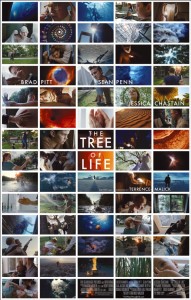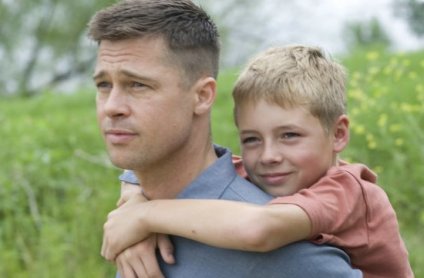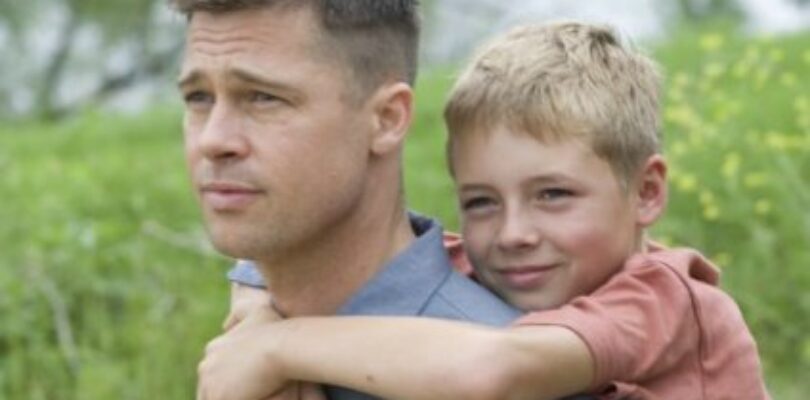Terrence Malick’s new drama, The Tree of Life, is reminiscent of his previous work, such as The Thin Red Line (1998), in that it is a film that focuses largely on ideas brought to life through cinematography. Although The Tree of Life does revolve around the story of a family, the movie is structured more through concept than plot. For example, the story isn’t told in a familiar, linear fashion, but in abbreviated chunks that jump through time. Since it can be difficult to piece together the particulars of the storyline, it seems natural to focus on what does connect the disparate film sequences – an artistic consideration of life, meaning, faith, and family. The Tree of Life is complex enough of a film that it is difficult to explain after only one viewing. However, this fact in itself should suggest that this is not your typical Hollywood blockbuster. The Tree of Life and director Malick aim to challenge, not just entertain the viewer.
 The basic plot focuses on the O’Brien family, an, initially, young couple (played by Brad Pitt and Jessica Chastain) with three boys in the mid-1950s. Due to the manner in which The Tree of Life bleeds time together, we are introduced to the eldest son Jack as a child (Hunter McCracken) and as an adult (Sean Penn) almost simultaneously. Because the viewer is able to see Jack at both stages early on, it becomes easy to focus on the transformation of young Jack to adult Jack, instead of searching for a linear progression. It is important to note that although there are jumps in time, writer/director Malick still manages to tell a story with a distinct progression. It is just a progression that includes gorgeous nature and space imagery in the midst of what would otherwise be a realistic family drama.
The basic plot focuses on the O’Brien family, an, initially, young couple (played by Brad Pitt and Jessica Chastain) with three boys in the mid-1950s. Due to the manner in which The Tree of Life bleeds time together, we are introduced to the eldest son Jack as a child (Hunter McCracken) and as an adult (Sean Penn) almost simultaneously. Because the viewer is able to see Jack at both stages early on, it becomes easy to focus on the transformation of young Jack to adult Jack, instead of searching for a linear progression. It is important to note that although there are jumps in time, writer/director Malick still manages to tell a story with a distinct progression. It is just a progression that includes gorgeous nature and space imagery in the midst of what would otherwise be a realistic family drama.
It is also important to note that this film explores some very serious theological issues, as evident in the Bible verse that opens the movie, “Where wast thou when I laid the foundations of the earth?” (Job 38:4). Whole portions of the movie can best be explained as prayer, or a cry of desperation, to an absent God. All the questions of faith posed by the film are also interwoven with questions of life, such as, what is love? What is family? This juxtaposition of spiritual and earthly concerns allows The Tree of Life to explore these issues without becoming didactic.
After the notable cinematography and script, the most exemplary aspect of The Tree of Life is the acting. Brad Pitt’s personal life is so often scrutinized by the media, thanks to the hordes of paparazzi following his every move, that it can be easy to forget that he’s actually a good actor. Pitt is at his best in physical roles (think Snatch back in 2000) and in The Tree of Life it is his physical acting that stands out the most. He fully inhabits the role of the father, from a young man to an older man to a graying man. Even though Pitt is a celebrity, he was able to embody his character to such an extent that one could forget about his notoriety. It was also pleasing to watch him successfully portray such an unattractive man, because it suggests a lack of self-consciousness that should be admired in today’s image-saturated culture. Another actor worth noting is Hunter McCracken as young Jack, whose performance had the subtle maturity of an actor well beyond his years. Jessica Chastain was also spot on as the mother, or perhaps, the idea of the mother, as all the characters in The Tree of Life seem to be more than what they appear on the surface, almost as if representations of a larger idea in a larger story than what is shown.
 Though The Tree of Life may not have a lot of inappropriate imagery, it is definitely an adult movie, in themes and content. It’s also a movie to reflect upon, to try and piece together in hindsight. Watching the movie is such an experience in itself it is difficult to make sense of it all immediately. But I believe that’s the fun of complex films. The Tree of Life is, so far, the best film I’ve seen all year. Terrence Malick challenges preconceptions about what it means to make a movie by delivering a film that is unique and yet successful. In a time of remakes and sequels, individuality always stands out.[box_info]WHERE TO WATCH (powered by JustWatch)
Though The Tree of Life may not have a lot of inappropriate imagery, it is definitely an adult movie, in themes and content. It’s also a movie to reflect upon, to try and piece together in hindsight. Watching the movie is such an experience in itself it is difficult to make sense of it all immediately. But I believe that’s the fun of complex films. The Tree of Life is, so far, the best film I’ve seen all year. Terrence Malick challenges preconceptions about what it means to make a movie by delivering a film that is unique and yet successful. In a time of remakes and sequels, individuality always stands out.[box_info]WHERE TO WATCH (powered by JustWatch)
[/box_info]

